by Tom Gaylord
Copyright PyramydAir.com ©2011. All Rights Reserved.
This article originally appeard in Airgun Revue #2, published in 1998.

Zimmerstutzen rifles: Are they firearms? Airguns? Neither? Both? Read on to find out.
Zimmerstutzens are neither fish nor fowl. To firearms collectors, they are considered to be either air- or even non-guns -- things that defy description. To some airgun collectors, they are simply firearms, and no argument about it! Occasionally, you will see a reference to them in a book about something else, but there has never been a book devoted entirely to them. Sometimes, the only information is embedded within the captions of photos and old catalog reproductions. And yet, strangely, many people have both heard of them and know what they are.
The Zimmerstutzen or parlor target rifle is a product of the society of the 19th century, when shooting was at its zenith the world over, and shooting champions were the superstars of the day. It was developed in parallel with the centerfire Schutzen rifle, but unlike those early black powder cartridge rifles, which evolved from earlier target muzzleloaders, the Zimmerstutzen was not an outgrowth of anything. It came into being suddenly, in the period immediately following the invention of the rimfire cartridge.
Perhaps it is not incorrect to suggest that the popular rimfire Flobert parlor guns had an influence on the Zimmerstutzen; but where the Floberts tended toward the amusement trade, Zimmers remained rigidly within the sport of precision offhand target shooting. Flobert guns have much more in common with .22 rimfires, although to confuse the situation there are some low-grade Zimmerstutzens based on Flobert actions. But the mainstream Zimmerstutzen rifles laid the groundwork for the precision 10-meter target airguns we enjoy today.
The usual explanation for the creation of these super-accurate rifles is that they were developed as off-season trainers for big-bore Schutzen shooters. That makes so much sense that we will accept it here. If there was another reason for their existence, it may never come to light. But once the shooters beheld all they could do with these fine sub-caliber pieces, a brand new facet of shooting began to take shape -- indoor target competition.

Left to right: #6 shot, Daisy .118 steel shot, 4.30mm Zimmerstutzen ball, Daisy BB, .22 round ball, .25 round ball
Because they are specifically designed for shooting indoors, the caliber range is very small -- nominally 4mm. Don't confuse this with other German 4mm rimfire and centerfire sub-caliber insert devices that have no relation to Zimmerstutzens, other than the coincidental caliber size. This article will not address those guns.
Zimmer bore sizes actually range from 4mm to 5.45mm, in increments of five-hundredths of a millimeter. There may be other sizes as well, but I have confirmed these through catalog references.
Zimmerstutzens were built to fire either a fixed round that looks like a tiny BB cap or separate ammunition components consisting of caps and balls. The fixed round -- where both case and ball are one piece -- is considered ammunition by BATF; and the guns that use it are, therefore, considered to be firearms in the US.
The separate caps for Zimmerstutzens are not ordinary black powder rifle percussion caps. Although there must certainly have been some guns that used them, those guns are not in the mainstream of what we are examining here.
There is a special Zimmerstutzen cartridge that has no flanged rim. It looks like an elongated percussion cap, and in the German language it is called a cap. Some references even label it a percussion cap, so perhaps this is where the confusion originates. I am not aware of a current source for these rimless caps.
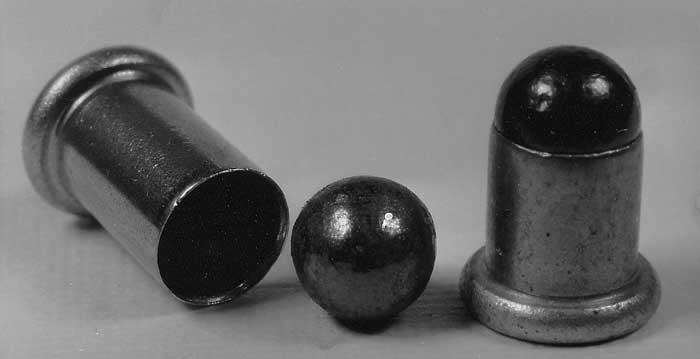
Zimmerstutzens are made for either separate cartridge and ball or fixed ammunition. A gun will shoot one kind only.
Zimmerstutzen ball sizes |
|||||||||||
| New number | 1 |
2 |
3 |
4 |
5 |
6 |
7 |
8 |
9 |
10 |
11 |
| Old number | 1 |
2 |
2-1/2 |
3 |
4 |
4-1/2 |
5 |
6 |
7 |
7-1/2 |
8 |
| Size | 4.00mm |
4.05mm |
4.10mm |
4.15mm |
4.20mm |
4.25mm |
4.30mm |
4.35mm |
4.40mm |
4.45mm |
4.50mm |
| New number | 12 |
13 |
14 |
15 |
16 |
17 |
18 |
19 |
30 |
21 |
|
| Old number | 9 |
9-1/2 |
10 |
11 |
12 |
13 |
14 |
15 |
16 |
17 |
|
| Size | 4.55mm |
4.60mm |
4.65mm |
4.70mm |
4.75mm |
4.80mm |
4.85mm |
4.90mm |
4.95mm |
5.00mm |
|
Notes:
|
|||||||||||
1. Stiegele sizes are the same as the new ball sizes, plus they continue from 5.05mm (size 22) to 5.45mm (size 30). |
|||||||||||
2. To convert millimeters to inches, multiply by .04. To convert inches to millimeters, multiply by 25.4. |
|||||||||||
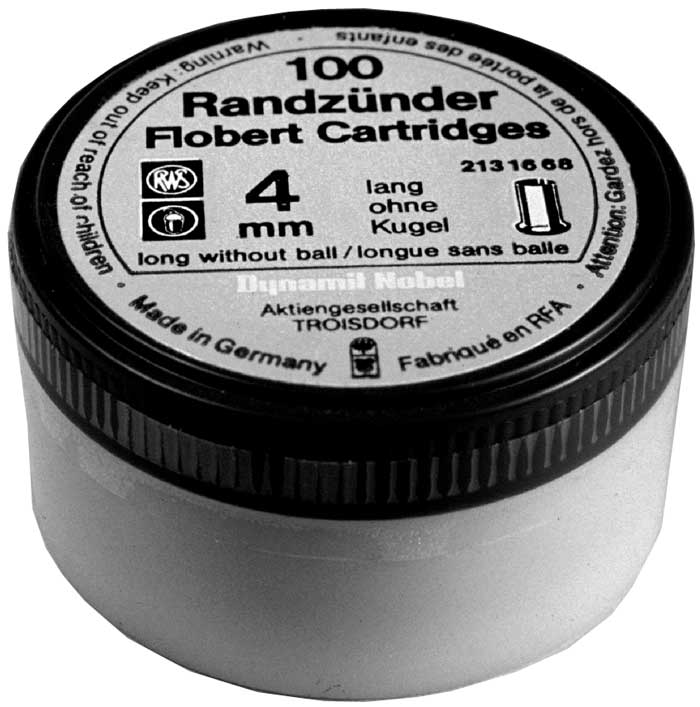
Separate 4mm cartridges come in both long and short lengths. In the past, they also came in varying levels of power.
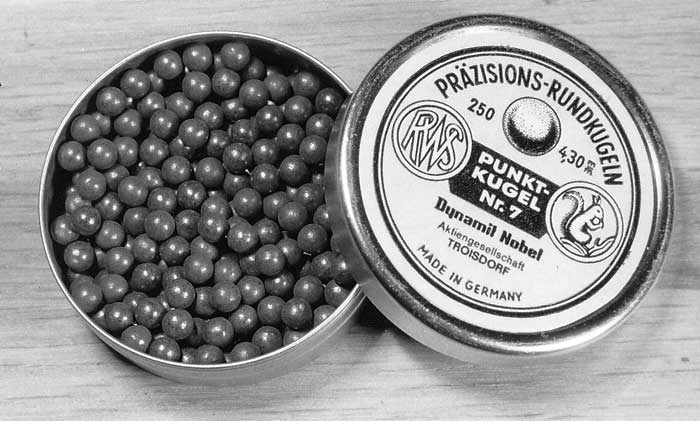
For rifles shooting separate ammunition, a tin of the correct size lead balls is required.
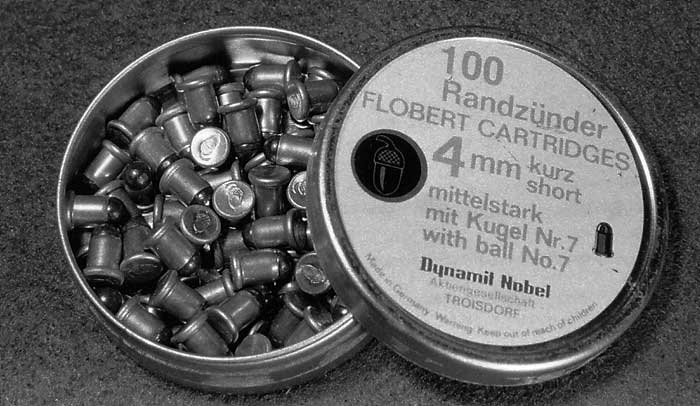
Fixed ammunition for Zimmerstutzens is also available, but BATF considers the guns that use it as firearms.
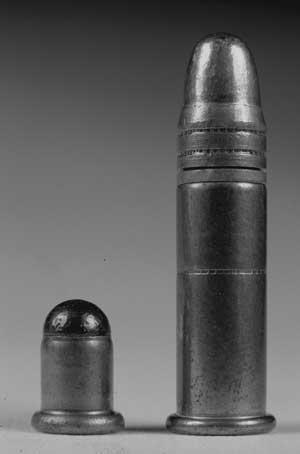
Although the 4mm Zimmerstutzen cartridge is dwarfed by the .22 long rifle, it's just as accurate, if not more so, at close range.
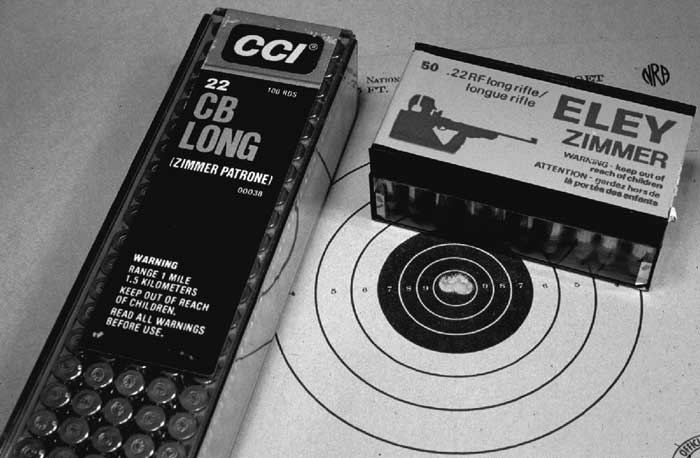
The Zimmer name has even spilled over to many brands of .22 rimfire CB caps.
The traditional Zimmerstutzen separate cartridge looks like an empty miniature .22 rimfire case. There is both a short and a long version of this cartridge, to fit two different standard chamber lengths. Priming compound is distributed around the inside base of the case and is covered by a paper vapor barrier. It is not crimped at the end, in the manner of some .22 rimfire blanks, nor does it resemble a cartridge for a nail gun. To the uninitiated, it looks like an empty rimfire case.
A further dimension to the cartridge is the fact that it used to be produced in low-, medium- and high-power levels to allow the shooter to adjust to the specific range conditions. A match at 10 meters might require less power than one shot at 15 meters -- or at least that's the thinking.
Zimmer ammunition IS NOT the same as the popular German 6mm BB and CB caps made and sold by RWS for Flobert guns. Those cartridges are much more powerful, to say nothing of their relatively large projectile size.
There is an unfortunate laxness in the categorization of ammo types, so both Zimmer rounds and the boxes of separate components often do carry the Flobert name. In fact, even some .22 rimfire ammo makes reference to either Flobert or Zimmerstutzens, so the field is quite ill-defined and ambiguous. Undoubtedly, there has been some crossover through the years to cloud the issue, but I believe this is due more to sloppy cataloging and advertising than to any real confusion on the parts of manufacturers or shooters.
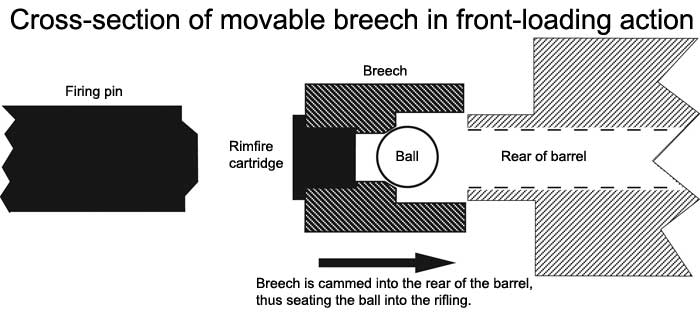

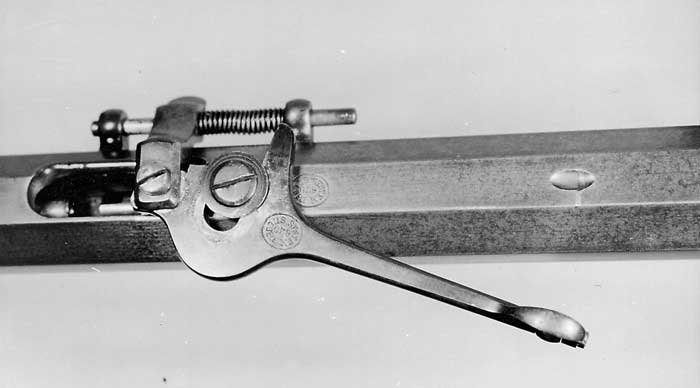
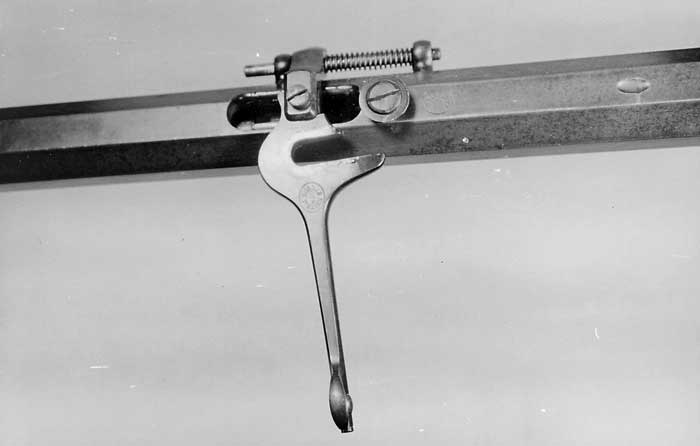
In the above three images, you can see the forward camming action of the Stiegele system.
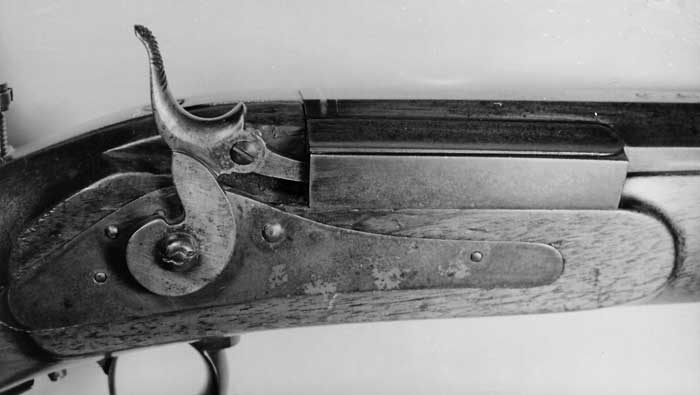
The exposed hammer is connected to a long firing pin that spans nearly the entire barrel. The vertical spur provides an easy cocking handle.
The guns themselves have varying sized bores, so one not only has to match cartridge length and power level, but ball size as well. With fixed ammunition, both case length and ball size must be correct, or accuracy will surely suffer. The same holds true with separate ammo, but you have a greater degree of flexibility when buying the components separately. I have even been able to use long cartridges in a short chamber without affecting the accuracy.
With separate ammunition, the tiny precision round lead ball is inserted in the front of a movable breechblock, where the camming action of the rifle's loading mechanism forces it lightly into the rifling at the rear of the barrel -- what we would refer to as the breech. This is supposed to be a more accurate method of loading than shooting a fixed round, where the crimping of the ball in the case mouth introduces distortion. I haven't had enough experience to comment on that theory either way.
Guns that use separate ammunition are invariably front-loading, but that doesn't mean what most people think. A black powder enthusiast would think of a gun that's loaded from the muzzle. But, while there may be a few Zimmerstutzens that are true muzzleloaders, the term "front-loading," as used here, implies something much different.
The rifle is loaded at the rear of a short rifled insert barrel, through a cutout in, what looks like, the barrel of the rifle. This loading port cutout is located seven or eight inches behind the muzzle, on the underside of the barrel. The firing pin is a long rod extending the full length of the barrel, from the action to the rear of the loading port. In the guns I have examined, this rod smacks the rear of the cartridge directly with enough force to ignite the priming compound. In the rifle I own, you can actually see the back end of this rod, where it connects to the exposed hammer by means of a screw. Other front-loading guns have enclosed actions, but the long firing pin rod is there just the same. When the cartridge goes off, the weight of the rod is the only support for the rear of the case -- the entire rim is exposed at all times.

This plain Zimmerstutzen was made in the 1870s by Cincinnati gunsmith J. Bandle. He also made gallery guns.

One recognizable feature of a Bandle gun -- the decorative brass studs interspersed throughout the checkering pattern.
Still other styles of Zimmers load from the true breech of the gun, just like any other firearm. Because of this true breechloading design, these are the guns that use fixed ammunition These rifles have the same short insert rifled barrel as the front loaders, only it's screwed directly into the action in the conventional manner. At the muzzle end of the insert is a long freebore space running out to the apparent "muzzle" of the long false barrel. At what appears to be the rifle's muzzle is a large open hole that can fool people into thinking the gun is something it is not.
In both instances, keeping the barrel insert short reduces friction on the ball, which is, after all, only powered by a tiny charge of priming compound. Although Zimmer ammo is much less powerful than even .22 rimfire CB caps, velocities tend to be much higher than those found in a modern target air rifle.
Ammunition design differences require this difference in velocity. Remember that Zimmers shoot round balls, where air rifles use diabolo pellets. Although the two projectiles weigh approximately the same (7.4 grains for the 4.3mm ball versus about 8 grains for the 4.5mm pellet), their ballistic characteristics are very different. Zimmer balls rely on uniformity and a rifling-induced spin for their accuracy; air rifle pellets use uniformity, spin AND the high air drag created by the open diabolo skirt. Zimmer balls leave the barrel at between 800 and 1,000 f.p.s.; target air rifle pellets are traveling 550-650 f.p.s.
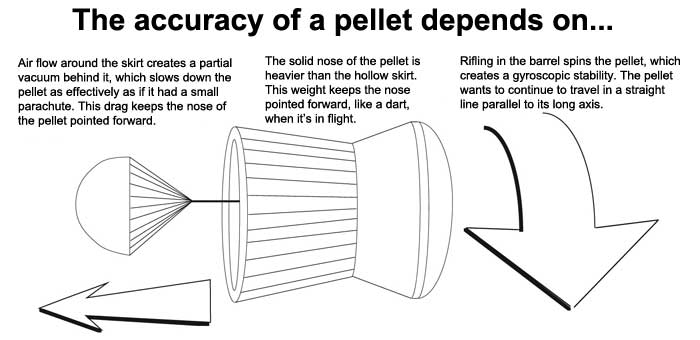
The short barrel insert of the Zimmerstutzen also means the ball leaves the rifle's influence quickly, a trait that many target shooters believe offers a significant advantage in accuracy potential. The top 10-meter air rifles made today all employ similar short rifled barrel sections, although none as short as the Zimmer, because they require certain minimum lengths to allow their powerplant to build velocity.
Front-loaded rifles built prior to about 1909 often use a non-cammed "spoon" to load the separate ball and cartridge. These spoons are actually the handles attached to the same movable breech piece and function in the same way as the later, more complex, mechanisms; but the simpler spoons require more manipulation on the part of the shooter when loading the gun.

The real breech of this rifle is about 7 inches from the muzzle. Note the swamped barrel.
An article written by Tom Anderson for American Airgunner magazine in 1991 tells of locating an older (pre-1900) Zimmer at a local gun show. The gun was missing its breech spoon, so the author had to fabricate one from scratch, judging sizes and tolerances from the parts on either end of the missing items. He made his new breech to accept modern pistol primers, which sounds like a very reasonable idea.
The only difficulty he encountered in the whole project was obtaining lead balls of the correct size for his 4.3mm bore. In the end, he resorted to using round ball airgun ammunition of 4.5mm. Although his bore measured 0.172", he shot a ball of 0.177" diameter through it -- with a resultant accuracy of only 2-1/2" at 33 feet. Anyone who shoots round balls in muzzleloaders might predict such poor accuracy from the amount of lead that had to be shaved as each ball was driven down the bore.
Any Zimmerstutzen in good order using the correct ball should be able to group 10 shots at a distance of 15 meters, or nearly 50 feet, in a single hole not much larger than the hole made by one .177 wadcutter pellet! Such groups are often shot from rested rifles, and sometimes even turn up in a match -- fired from the offhand position!
The rifling in these guns is quite fine, with 12 lands and grooves being common. The bores were honed before the cutter made its first pass, in the manner of the great barrelmakers of the previous century. Even Zimmers made at the end of the era, in 1935, are as carefully built as if Harry Pope personally supervised each one. Although this level of work is not impossible to replicate today, it would be remarkable if anyone did!
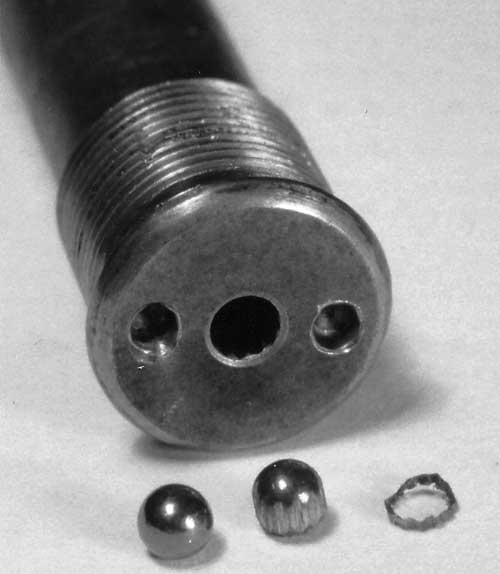
A Gamo lead ball was large enough, at 0.176 inches, to slug the bore. Note the fine rifling engraved on the slug.
My own interest in these rifles began in the early 1960s, when I read about them in an article in Guns & Ammo. From that moment on, there's been a special place in my heart for the guns, although it took me another 30-plus years to acquire one.
They are somewhat scarce here in the US; so when the Army sent me to Germany in the 1970s, I was very hopeful of finally locating one. Surely the country of origin would be rich with Zimmers just waiting for an eager collector, like me.
Wrong! Germany, in the early 1970s, wanted nothing at all to do with her past. Everyone was on a modernization kick. They were tossing out all their antiques and rapidly acquiring furniture and possessions that looked like they belonged in a British mod movie or a dentist's office. Lucite coffee tables with chrome legs and pastel leather furniture displaced the solid wooden furniture of the early part of the century (and earlier!). Although I pestered the local gun shops, there wasn't a Zimmer to be found. Alas, I returned to the States without my rifle.
The tour wasn't a complete failure, though. In the historic town of Rothenberg on the Tauber, I stumbled onto modern adult airguns by accident while searching for my Zimmer. Fortunately, Germany was (and still is) quite active as a center of precision airguns, so there has never been a dry spell for me with airguns from that day on.
The Zimmerstutzens I seek are the period pieces from about 1910 to 1935. Those were the glory days. They lasted right up to the point when the German legislature put an end to the civilian federal shooting program, in preparation for war. Rifles made during this period represent the top level of both design and accuracy. They fully rival the finest Schutzens for craftsmanship and decoration.
So, after seeing a fine Zimmer at the big Baltimore gun show in March of 1997, I resolved to take action. It took a few more months to acquire a rifle, but all that time I also vowed to do more than just own and shoot my own rifle. I would help spread the word about these poorly documented guns, so others might enjoy them as well.
The gun I finally bought was as different as any Zimmer ever could be, yet it fits exactly into the mainstream of the type. It was made by none other than C. Stiegele of Munich. And, it has a swamped barrel -- the only one I have ever heard of!
There is a definite swelling at the muzzle, which is one sign of a better barrelmaker. It's not easy to taper eight octagon flats by one-tenth-inch diameter over five or six linear inches of iron, while the rest of the run is parallel. Most makers never bother to do it, but the few who did marked their guns with a hallmark of quality that can never be erased by the ravages of time or neglect.
But the rest of the rifle wasn't at all what I had expected. The whole thing was too short -- almost a carbine. At 41 inches, this is the shortest Zimmerstutzen I have ever seen or even heard about. It looks more like a Jaeger stalking rifle than a target gun. I was momentarily crestfallen at the thought of yet another gun failing to assuage my lust for the true Zimmer.
Then I hoisted it to my shoulder and felt the balance. All my angst dissolved, when the fine balance of the rifle played itself out in my hands. This is actually a perfectly balanced offhand target rifle. The extra metal of the swamped barrel lends just enough mass at the muzzle for the rifle to stabilize in my off hand -- which finds the exact balance point of the stock quite readily. Apparently, this rifle was made for a person proportioned much like me.
Initially, I had no idea what size balls were needed for this gun, nor was I aware of any source for them in the US. But I've been a muzzleloader and a bullet-caster long enough to know how to begin.
I removed the short barrel insert to slug the bore. Being an airgunner paid off here, because I have many thousand round lead balls in nearly the correct caliber. A Gamo .176-inch diameter pure lead ball was used. Tapping it into the breech shaved off a ring of lead that was uniform, which means the slug was centered as it entered the bore.
The ball passed through the bore without any loose spots, indicating a uniform barrel diameter all the way through. With some of the button-rifled barrels today, that's uncommon. There are almost always loose spots and constrictions, where the metal springs back after the pass of the button, but this barrel had been cut-rifled in the traditional way -- one groove at a time.
The ball emerged showing 12 lands and grooves, with a bore diameter of 0.1687 inches. Knowing how hard it is to accurately mike such a small object -- especially one made of soft lead, I allowed for some inaccuracy in the reading.
The rifle is marked with the number five on the barrel jacket, just in front of the forearm. That's a common place for the ball size to be marked. Since this is a Stiegele, the size should be theirs, but as noted in the table pm page 36, Stiegele sizes correspond to the new size designations for balls between 4mm and 5mm. Size five is 4.20mm, which converts to 0.168". So I figured the bore size I got from slugging was in the right ballpark.
However, the marked ball size is nearly one full thousandth UNDER the true bore size, according to my measurements, and that didn't sound too good. I expected it to be at least equal to the bore size or even a thousandth over -- not under. So, with the wisdom that all tinkerers possess, I figured I knew more about the gun than its maker and went with ball size seven -- which is 4.30mm. That comes out to 0.16985".
My next job was to locate ammunition. A call to Col. Brett Boyd at the Single Shot Exchange netted me both a subscription to his fine monthly publication and the phone number for John Gary Staup. Gary is a Zimmerstutzen collector and noted authority, along with his duties as Secretary of the Single-Shot Association. He informed me that The Old Western Scrounger in California carries RWS Zimmerstutzen ammunition, so I went on the Internet to check them out.
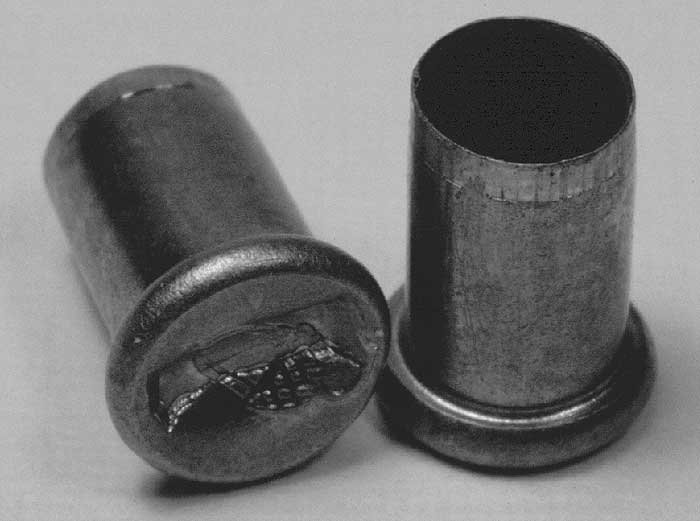
The 4mm long case is slightly too long for the chamber. The firing pin leaves a deep dent in the other end.
Sure enough, they do carry some sizes of lead balls; but, as I didn't yet have the ball sizes table to work from, I placed an order on the phone -- telling them that I needed 4.30mm balls. Let them figure out which number that converts to.
Gary also thought that my Zimmer might use the long caps because it was possible to completely chamber the fixed ammunition that came with the rifle into the rear of the movable breech. So, I placed an order for several hundred balls and long caps. You can contact The Old Western Scrounger at 800-877-2666 for orders, or 916-459-5445 for customer service/catalogs.
After some initial shooting, and after I didn't get the accuracy I'd been hoping for, I went back and discovered my mistake with the ball sizes. I should have gone with the Stiegele number five ball from the start. In a second call to The Old Western Scrounger, I was informed that they only carry separate balls in sizes seven and larger, so there wasn't any way I could get size five from them.
I had also discovered during shooting that the long cases were both hard to fully seat and to eject from the movable breech. A look at a fired case with a 10X jeweler's loupe told me why. The cases were being swaged down at the mouth about 1-2 millimeters back. They were too long! My rifle was actually chambered for the shorts. Fortunately, The Old Western Scrounger had shorts in stock, so I ordered several boxes to continue my testing. The longs will still work; but they're hard to seat, and sometimes they don't go off on the first try if they haven't been seated all the way.
I next faxed Frankonia-Jagdt in Germany, to see if they had the separate number five balls I required. Apparently, either my German wasn't that specific or they did not have what I needed, for they faxed back a price for the loaded ammunition only. I do believe that the German firm of Haendler & Naterman (H&N) still makes the smaller balls, but there isn't enough of a demand to warrant their importation into this country.
I am having a special barrel made for my rifle to enable the use of .177 lead balls, which are readily available from both H&N and Gamo in the US. The original barrel will remain intact for posterity, but the new .177 barrel should prove to be far more accurate.
System Stiegele
Gary Staup also has a large collection of original Zimmerstutzen paper, and from that he has learned that the front-loading action that characterizes the classic rifle was invented by the Stiegele company prior to 1910, for it appears in a catalog of that date. I was really excited to learn that, for, as mentioned earlier, my rifle is marked "C. Stiegele -- Munchen" on the top barrel flat. By the front loading port are two oval stamps declaring the action to be "System Stiegele." In German, the word system is used similarly to how we use the term action, so these stamps identify a genuine Stiegele action.
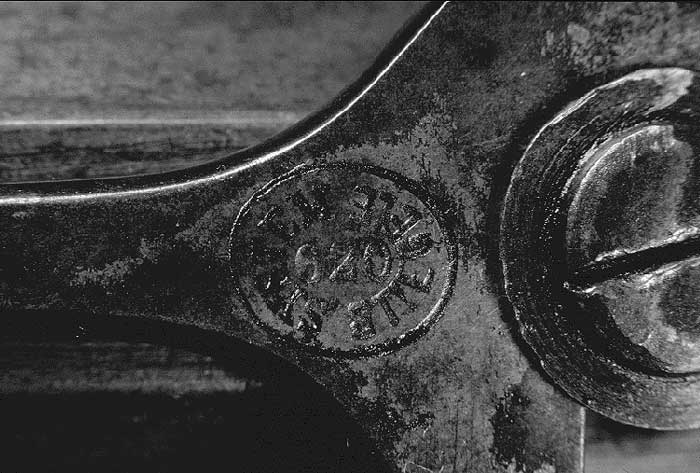
The oval Stiegele stamp is found on both the breech mechanism and the rifle.
Carl Stiegele was a manufacturer of fine Schutzen rifles, so it is only natural that he would also include Zimmerstutzens in his line. Many of his customers would own both a Schutzen for regular shooting and a Zimmer for the inclement months, in the same way that military high-power shooters today sometimes bed a 10-meter air rifle action into a regulation M1A stock for additional training. They would want the same heft and feel in both rifles, so the full training experience would not be lost when using the indoor gun. How better to accomplish that than to have both rifles made by the same maker?
Stiegele's action is a floating breechblock that swings into alignment with the barrel, then cams into lockup with an easily operated lever. The camming action forces the separate ball into the rifling at the rear of the barrel. Both the cam and ball seat are precisely machined, so each ball is seated exactly the same. This promotes accuracy, which is the name of the game.
Stiegele wasn't alone in patenting the floating breech action. There were several others who had their own proprietary designs. Some of them even include automatic ejectors for the fired cartridge, a feature the Stiegele lacks -- at least on the example I own.
Zimmers were not proofed, which seems reasonable, if you think about it. The tiny 4mm cartridge contains no powder, so it can never reach a high pressure -- even in terms of rimfires. Almost anyone could make them -- and they did! In Germany, you can see 4mm rifles built on surplus Mauser bolt actions, Martini dropping blocks, Flobert rolling blocks, Aydt falling blocks and just about anything else that can hold a barrel and sights. Some load at the rear of the barrel like a conventional breechloader, but the front-loading mechanism has always seemed to me to be the classic style.
Here in the US, though, we usually encounter the more elaborate examples, probably because the plain ones would have been less desirable to bring back from Europe. Although they could not be said to be common in this country, there are a fair number of them in circulation. I believe that the lack of knowledge about the gun is what keeps them in circulation, and also keeps the prices in line. After all, who wants a gun they think they can't shoot? Perhaps a few diehard collectors don't mind hanging them on the wall, but the unique style of the Zimmer seems to invite shooting -- even if only infrequently as a curiosity.
While prices vary widely due to a lack of market exposure and general knowledge, there aren't many people who don't recognize the inherent value of these fine target arms when they see them. Often, this works against the person who is seeking one, as an owner may ascribe a highly inflated value, because of the gun's supposed rarity. I will make no attempt to give a detailed price guide here, but there are some simple guidelines to follow.
Rifles made from the better actions command higher prices, almost without regard to their condition. Almost anyone can tell the difference between a simple Flobert rolling block and a fine Aydt dropping block action. The former will almost invariably have the less elaborate rear sight and sport almost no stock or metalwork embellishments. The latter will probably have a variable diopter rear sight and at least some stock work. For guns of the same general condition, I would value the Aydt or Martini at least twice as high as the Flobert.
Maker names are important, too. Some of the better ones are: Stiegele, Aydt, Haenel, Martini, and Bayerl, to name a few. Mauser and, quite surprisingly, J. G. Anschutz, are a couple of makers of the plainer, lower-grade bolt-action guns.
Fancy decorations also come into play. The better guns will at least have a checkered wrist, and perhaps some simple lines of scrollwork in the wood. The schnabel may be fluted, as well.
Look for a fluted barrel on the higher grades. This is a non-essential piece of work that denotes a labor of pure love. Some of the metal fluting is very fancy, with smaller flutes and decorative cuts inside the larger ones. Also look for decorative work around the muzzles of fluted-barrel rifles. And examine the fineness of the metal preparation and bluing on these guns, as it is extremely time-consuming to polish the small detail areas within the flutes.
As the decorations increase, look for finely engraved hunting scenes or target shooting scenes on both sides of the lock. The deeper the engraving, the higher the grade. Top Zimmers will be engraved with bas relief. The finest examples will also have contrasting metals and mother-of-pearl inlaid into the stocks and the metalwork. Look for German silver and real silver on the best guns.
A plain Mauser or Flobert rifle in average working condition might command $300-400 today. In excellent shape, the same gun may be worth as much as $600, or so. They don't really rise much above that -- and only that high for a really pristine gun. A mid-grade rifle from a top maker might start at twice these figures, and increase even more as condition rises.
For the very finest examples with lots of decorative work, price is determined by the seller and the buyer on a per-case basis. In other words -- don't ask! Of course, these numbers are determined by the relative experience of both the seller and the buyer. Strange things can and do happen every day.
Beware of guns that have been repaired. Front sights are especially vulnerable. Often one or both protective ears have been broken off, which usually means the thin post has been destroyed as well. The removable front sights are subject to someone having lost them over the years, and a cowboy gunsmith replacing them with something completely inappropriate, like a Lyman 17A. The rear diopter is missing in a significant number of cases, often being replaced by a lesser grade sight. The rear sight in the middle of the barrel is another casualty. Sometimes all that remains is a dovetail, but on my rifle there are two exposed screw holes that look incongruous.
Besides sights, stocks are another high failure-rate item on a Zimmer. Usually, the wrist will have broken as the result of a fall when someone tried to stand the gun in the corner on its butt. Sometimes, it's the thumbrest on the side of the wrist. The acorn finial is often missing from the top of the buttplate -- I believe as the result of curiosity. Someone removes it and it's lost.
Besides their cost and general lack of publicity, another thing that keeps Zimmers out of the mainstream is the cost of the ammunition. From The Old Western Scrounger, 100 rounds will set you back about $7.50 or more. That may not seem like a lot to a centerfire shooter, but any .22 rimfire shooter knows several sources for a 500-round brick at about $10. Never mind that they don't personally use such bargain ammunition for anything other than plinking, the price sticks in their mind. And airgunners, who today routinely out-shoot both Zimmers and .22 rimfire match shooters at ranges out to 50 yards, use pellets costing only $15 or less for 1,000 world-class rounds. Even the top Olympic airgun shooters are shooting for pennies compared to Zimmer ammunition. So you've gotta love 'em to wanna shoot 'em!
A sad note
One sad side note to the cost and supposed unavailability of 4mm ammunition is that some American-owned Zimmerstutzens have been "converted" by the good ol' boys to shoot "real" ammunition, completely disregarding the danger to both rifle and shooter, alike. Remember -- these guns are not proofed!
People drill out the chambers of the movable breech sections on the front-loading rifles to accept the .22 rimfire cartridge, and they install short sections of .22 rimfire barrel in the muzzles of vintage Zimmers to get them shooting once again. With breechloaders, it's even easier -- just install a short barrel section with the chamber already present. This job can quite literally be done at the kitchen table, excepting the threading of the new insert barrel. The resultant accuracy will probably be atrocious, however.
Any such conversion spells death to the rifle. Not only does it ruin any collector value, defacing a fine target gun that could have continued shooting accurately for centuries, it also endangers anyone foolish enough to shoot it with the much more potent .22 rimfire ammunition. Swelled chambers and burst cases will be the rule with the front loaders, as the case has nothing supporting its base except the firing pin! With breechloaders, there is more to back up the rim, but the gun is still not proofed.
The destruction of fine guns through this kind of conversion causes an increase in value to the remaining supply, but that's not how collectors view it. A .22 rimfire is just about the cheapest firearm known -- why ruin a fine vintage gun to get one? If you find a Zimmer that has been converted in this way, DO NOT attempt to shoot it with .22 rimfire ammunition. Even the lowly .22 CB cap has much more priming compound to launch the 26-grain bullet it carries than the 4mm rimfire cap has for its 7-grain ball. At the very best, you will have an extraction problem. Either make the parts to restore the gun to its original caliber or leave it alone. Conversions of this sort make great wall-hangers and parts guns.
The sport of shooting Zimmerstutzens
In the 1960 Shooter's Bible, there's an ad for a drop-in Zimmerstutzen barreled action for the Anschutz 1407 target rifle. They tout the 4mm system as "an inexpensive and quiet indoor training system for your target rifle." Imagine that -- a drop-in inexpensive indoor trainer conversion for an already-inexpensive indoor trainer! The Zimmer is accurate to 50 feet, which is also prime .22 rimfire territory. So here is a quieter, cheaper (in 1960) way to shoot your .22. What would come next -- pellets?
As a matter of fact, pellet rifles were fast becoming more accurate in 1960. Soon, they would exceed even the .22 rimfire at short ranges. And, when you take into account their vastly superior range safety characteristics, they wouldn't take very long to displace the rimfire altogether at the shorter distances. In the recent 1996 Olympics in Atlanta, a full one-third of the shooting events were for airguns.
The rules of Zimmerstutzen competition appear to have changed over the years. On page 336 of the 1960 Shooter's Bible, the rules for competitive Zimmerstutzen matches are given, and the range is stated as 15 meters. Another reference I have says 10 meters. A German catalog from the 1920s says the distance is 10 paces, so who knows for sure? Today, Zimmer shooters shoot at 15 meters, which is close enough to 50 feet that it will work.
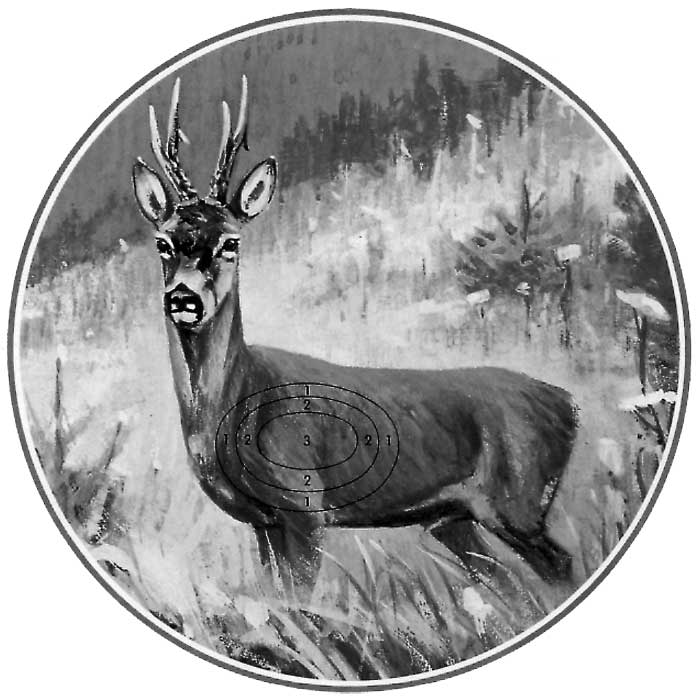
Zimmerstutzen deer target.

Zimmerstutzen bird target.
The Stoeger rules go on to specify that the rifle may not weigh more than 16 lbs., which seems strange, since we would expect the weight to be specified in kilograms, not pounds, in a 1960 publication. Perhaps the author was borrowing from a much earlier rule book. Curiously, it also says that handrests are forbidden in competition, yet Gary Staup has in his collection a beautiful Haenel Zimmer with a short handrest.
It has been reported many times that these guns are very quiet. I'm sorry, but I will have to disagree. The front-loader I have is just as noisy as a .22 rimfire shooting CB caps. Outdoors it might not be bad, but in an enclosed space -- watch out. I always wear hearing protection when I shoot my Zimmer. Perhaps the true breechloaders are quieter because their long freebores act like silencers, but I would still advise hearing protection in enclosed spaces.
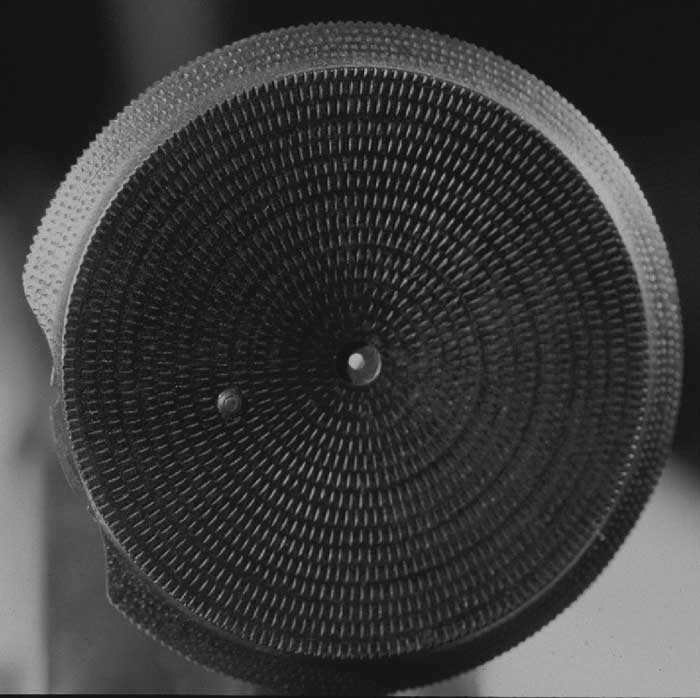
The cutout on the left of this sight exposes the aperture selection wheel. That's a small hole to peep through, isn't it?
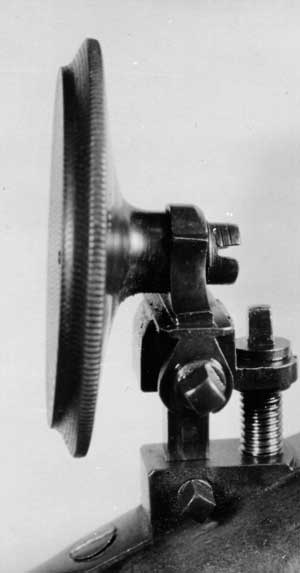
This sight is adjusted by a clock key. Wonderfully minute changes are possible because there are not fixed detents.
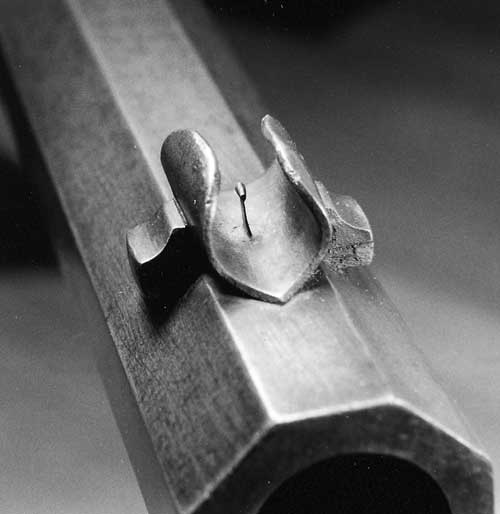
That tiny post and bead have been protected over the years by those stout steel "ears." This demonstrates the thought that went into these rifles.
The sights
Besides the caliber, sights are one of the defining characteristics of a Zimmerstutzen. They also serve to separate the informal 4mm sporting rifles from the far more serious target models. A serious Zimmer has a rear sight that looks like a satellite dish!
Among military pilots, the size of the wristwatch is a faux status symbol. With Zimmerstutzen owners, it's both the size and number of functions contained in the rear sight. After all, these aren't magnum guns -- so velocity and muzzle energy are not important. And, accuracy is a given. But you gotta have sights, and if you want to be respected and envied, the one in the back has to be big!
First, there's the sheer diameter of the diopter housing, which can top three inches in extreme cases. The one on my rifle is a rather conservative 55mm, or just over 2-1/8 inches wide. On an inexpensive gun, there is usually a deeply cupped metal dish measuring about one inch across. These are only found on lesser guns or sometimes as replacements for lost originals. I don't know why, but a lot of original diopter sights are missing from Zimmers when you find them. It's easy to say someone has borrowed them for their Schutzen rifle, but how were THOSE sights lost? It will remain a mystery, I guess.
Built into the better grades of rear sights is a diopter adjustment wheel, with six or more selectable hole sizes. The wheel is controlled by a precise spring-loaded detent, so each diopter aligns perfectly. This feature enables the shooter to adjust for the light on a particular range. You want to shoot with the least amount of light that enables you to see the target clearly. Lowering the light level forces your sighting eye to align with the exact center of the hole, which is where the greatest amount of light can be perceived. This forces your brain to automatically select the same spot to position your head (and eye) each time, which eliminates the shooter parallax problem -- remember B-R-A-S-S from your marksmanship training? This takes care of the spot-weld.
The very best rear sights can also have a selection of colored filters to further sharpen the sight picture. And, magnification was also available, in the form of a glass with no more than 1.5X, which allows older eyes to better acquire the tiny front sight.
Despite the variations in size and features, though, all the aperture sights I have seen and read about share one thing in common. They all adjust with a clock-type key. Original keys most often fit more than one size post; but if they aren't with the rifle, as is often the case, a couple of plain old clock keys serve the purpose just fine. Most rear sights have three square posts -- one each for windage and elevation and the final one to remove the sight from the rifle.
The other type of rear sight found on some Zimmerstutzens has me completely puzzled. Not all rifles have them, but a fair number are provided with open notch rear sights, located just behind the middle of the barrel jacket. Some of these are very finely adjustable, but others appear to be simple express-type sights with wide "V" notches. There are even folding blades of varying heights, similar to what would be found on an African big bore rifle of the previous century! I have found no explanation for the existence of this sight, which seems to be redundant, in light of the enormously precise rear aperture invariably mounted behind it.
The front sight is just as specialized as the rear, if not as adjustable. The standard is an extremely thin post with a tiny round bead on top. The shooter simply centers this bead in the bull, while looking through the rear aperture. No thought is required to use sights like this -- they are as automatic as a scope, once the shooter understands how they work.
Some people avoid aperture sights, believing they must somehow align BOTH the front and rear elements with the target, but that would be almost impossible. Instead, it's almost like looking at something through a red dot sight -- whatever you touch with the dot (front bead) is what you hit.
Another standard item for the front sights are a pair of protective "ears" that surround the fragile post almost completely. Complete globes are sometimes seen, but the ears are more common. They allow cleaning of the tiny post, and so represent a better design, in my opinion.
Although the actual post looks like a pin to the shooter, it has some front-to-back dimension to give it some strength. I have seen far fewer of these sight units missing from guns, although it does happen, and can be troublesome to remedy. More often, they have been damaged in a fall. Why the Germans didnt use the replaceable element-type globe sights that were at least a quarter of a century old (or more) by that time is another mystery.
On the finer Zimmers, the front post has four elements with different shapes. Usually, these will be three different beads and a single square post. They rotate on a wheel and are locked in position by a spring detent or friction lever. A clock key similar to the one used to adjust the rear diopter is used to select the desired post, whose wheel hub protrudes from the right of the sight base as a square post. Besides the caliber, sights are one of the defining characteristics of a Zimmerstutzen. They also serve to separate the informal 4mm sporting rifles from the far more serious target models. A serious Zimmer has a rear sight that looks like a satellite dish!

Don Raitzer's Bugelspanner airgun is almost a Zimmerstutzen.
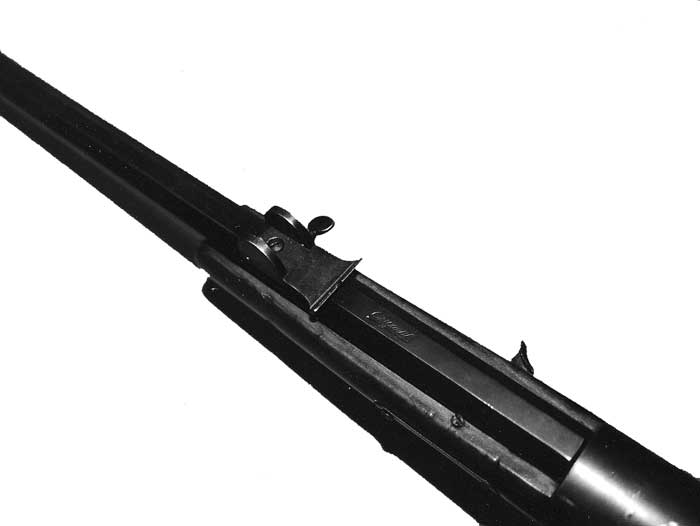
Raitzer's airgun even has the sporting rear sight, although it's missing the target aperture in the rear.

Larry Hannusch has a fine Bugelspanner airgun that could hold its own with any Zimmerstutzen (for appearance, not accuracy). It has both sets of rear sights.
The Zimmerstutzen's influence on airguns
In the German catalogs from the 1920s and earlier, which Gary Staup was kind enough to furnish for reference, I can see parallel lines of style and development between airguns and Zimmers of the period. The stocks, sights, general proportions and even the terminology of the two are remarkably similar. As an example, any airgunner knows what a Bugelspanner is -- it's an airgun that cocks by means of a movable triggerguard. It's literally a "triggerguard-cocker." But in the German catalogs, ANY gun that cocks by using the triggerguard is a Bugelspanner, including a lot of firearms and, of course, many Zimmerstutzens. A Ruger Number 1 would be a Bugelspanner.
The airgun form of the Bugelspanner has existed since at least the 1840s, and firearms aficionados can even see a "Sharps" air rifle, which Christian Sharps presented to his 10-year-old daughter, on page 108 of Frank Sellers famous book, Sharps Firearms. This rifle (more probably a smoothbore) bears a strong resemblance to the European Buglespanners of that period.
Airgun collector Don Raitzer has an airgun Bugelspanner that even has the sporting rear sight midway up the barrel, like many Zimmers had originally. Ironically, Don's gun is missing its rear diopter, just like many Zimmerstutzens.
Collector and historian Larry Hannusch has an even more elaborate airgun with both rear sights. This one is decorated very much like the next-to-highest grade Zimmerstutzens, and is difficult to recognize as an airgun at all. Larry correctly considers his piece to be a parlor airgun; but, except for how it is powered, a Zimmer collector would recognize it just as readily.
Airgunners would accept both Don's and Larry's guns as simply elaborate versions of the airgun Bugelspanner that is so well-recognized to enthusiasts. Most would be quick to point out that Zimmerstutzens are firearms -- not airguns.
In contrast, I find the similarities between target airguns of the late 1800s and Zimmerstutzens suggest strongly that these were just two different ways of powering the same kind of gun -- a target rifle. I'm not implying that the airguns were ever used in formal Zimmerstutzen matches; I don't think they were. But, if this trend of parallel styling had continued long into this century, I think the two would have blended into one. It would certainly be possible today to make an air-powered Zimmerstutzen that could compete at all levels. In fact, the Feinwerkbau 300 Tyrolean is such a gun, just to name one.
The Zimmerstutzen is one of life's little curiosities. A thing that is difficult to categorize, yet is almost universally revered. If you appreciate the art of the gunmaker and have a yen for old world craftsmanship, this little rifle might be just what you've been looking for.
Buy With Confidence
Get FREE shipping on qualifying orders! Any order $150+ with a shipping address in the contiguous US will receive the option for free ground shipping on items sold & shipped by Pyramyd AIR during checkout. Certain restrictions apply.
Free shipping may not be combined with a coupon unless stated otherwise.
View Shipping Info
We work hard to get all orders placed by 12 pm EST out the door within 24 hours on weekdays
because we know how excited you are to receive your order.
Weekends and holiday shipping times will vary.
During busy holidays, we step our efforts to ship all orders as fast as possible,
but you may experience an additional 1-2 day delay before your order ships.
This may also happen if you change your order during processing.
View Shipping Times
It's important to know that due to state and local laws, there are certain restrictions for various products.
It's up to you to research and comply with the laws in your state, county, and city.
If you live in a state or city where air guns are treated as firearms you may be able to take advantage of our FFL special program.
U.S. federal law requires that all airsoft guns are sold with a 1/4-inch blaze orange muzzle
or an orange flash hider to avoid the guns being mistaken for firearms.
View Shipping Restrictions
Get the most out of your equipment when you work with the expert technicians at Pyramyd AIR. With over 25 years of combined experience, we offer a range of comprehensive in-house services tailored to kickstart your next adventure.
If you're picking up a new air gun, our team can test and tune the equipment before it leaves the warehouse. We can even set up an optic or other equipment so you can get out shooting without the hassle. For bowhunters, our certified master bow technicians provide services such as assembly, optics zeroing, and full equipment setup, which can maximize the potential of your purchase.
By leveraging our expertise and precision, we ensure that your equipment is finely tuned to meet your specific needs and get you ready for your outdoor pursuits. So look out for our services when shopping for something new, and let our experts help you get the most from your outdoor adventures.
View Service Info
Shop and purchase with confidence knowing that all of our air guns (except airsoft) are protected
by a minimum 1-year manufacturer's warranty from the date of purchase unless otherwise noted on the product page.
A warranty is provided by each manufacturer to ensure that your product is free of defect in both materials and workmanship.
View Warranty Details
Didn't get what you wanted or have a problem? We understand that sometimes things aren't right and our team is serious about resolving these issues quickly. We can often help you fix small to medium issues over the phone or email.
If you need to return an item please read our return policy.
Learn About Returns
Get FREE shipping on qualifying orders! Any order $150+ with a shipping address in the contiguous US will receive the option for free ground shipping on items sold & shipped by Pyramyd AIR during checkout. Certain restrictions apply.
Free shipping may not be combined with a coupon unless stated otherwise.
View Shipping Info
Want More?
Join Our Email List for News and Deals!
Join the Pyramyd AIR mailing list: Our e-mails are filled with new products, deals, sneak peeks, tips and tricks, contests and more - sign up today!
Text JOIN to 91256 and get $10 OFF Your Next $50+ Order!
* By providing your number above, you agree to receive recurring autodialed marketing text msgs (e.g. cart reminders) to the mobile number used at opt-in from Pyramyd AIR on 91256. Reply with birthday MM/DD/YYYY to verify legal age of 18+ in order to receive texts. Consent is not a condition of purchase. Msg frequency may vary. Msg & data rates may apply. Reply HELP for help and STOP to cancel. See Terms and Conditions & Privacy Policy.